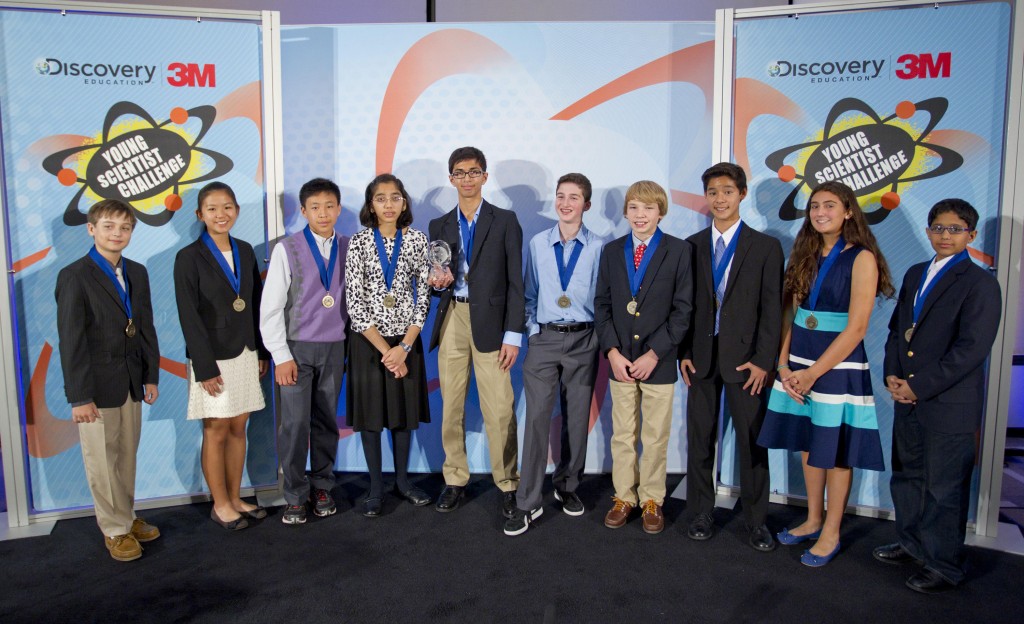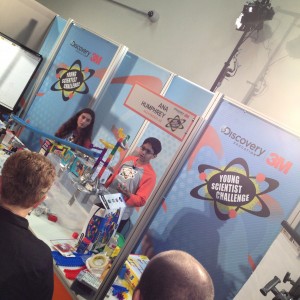Tag: Innovation’
Discovery Education 3M Young Scientist Challenge for Kids in Grades 5-8
- by KitchenPantryScientist
I don’t typically write sponsored posts, but I love this contest so much that I’m more than happy to spread the word about it! Last year, I was lucky enough to hear the ten Young Scientist Challenge finalists present their innovations and was blown away by their creativity, their knowledge, and their passion for helping create a better world for everyone to live in.
The Discovery 3M Young Scientist Challenge “targets students in the years when research indicates their interest in science begins to fade and encourages them to explore scientific concepts, apply those concepts to everyday life and creatively communicate their findings.”
My 8th grader fits this description. He loves science, but hasn’t had opportunity to do much hands-on experimentation at school, and he’s bored. Last year, he entered the Young Scientist Challenge and came up with a tornado protection blanket made using a non-Newtonian fluid. He didn’t make it to the finals, but the fire was kindled. He was blown away by the finalists’ presentations and how much his peers knew about science and technology. Now, he tells me that he thinks about the 3M Young Scientist Challenge almost every day and seems determined come up with an idea that will take him to the finals this year for a shot at the $25,000 grand prize!
Whether he makes it to the finals or not, I couldn’t be happier. He’s engaged, he’s excited, and he’s working to think creatively.
Anyone in grade 5-8 can enter! Share the science behind a possible solution to an everyday problem in a 1-2 minute video at www.YoungScientistChallenge.com. Entries are due by April 21, 2015!
Hints for kids entering the contest: First of all, watch the finalists’ entry videos from last year! Then, think about a problem that needs solving, which is always a great exercise, whether you’re thinking locally or globally! If you’re stuck, read the news, make a list of problems and choose the ones you’re most interested in. Then, read more about the issues and brainstorm solutions. Remember, you’re not being graded and that there are no wrong answers.
Hints for parents: You’re only there to guide your kids, and remind them that some ideas (i.e. new ways to kill Ebola) may be too unsafe to investigate at home. You’ll be amazed at how smart they are!
The ten finalists in the Discovery Education 3M Young Scientist Challenge will each be paired with a 3M scientist mentor. The mentors will help guide finalists to create an innovation that will be presented to a panel of judges at the final competition at the 3M Innovation Center in October.
Follow the competition on Twitter at @DE3MYSC and on Facebook at https://www.facebook.com/YoungScientistChallenge
On Twitter? Join in Thursday evening, March 5 at 9 PM Eastern for the March #STEMchat. TheMakerMom.com is partnering once again with the premiere science competition for middle school students, the Discovery Education 3M Young Scientist Challenge. This year, the theme for our chat is applying science to everyday life. (This post is sponsored by #STEMchat.)
Blundering Into Innovation
- by KitchenPantryScientist
I was thrilled to see the words “In Praise of Failure” emblazoned across the New York Times Magazine innovation issue Sunday morning and to read stories that illustrate that there is no substitute for trial, error and risk-taking in the process of invention. It reminded me that I’ve been meaning to write about a fantastic kids’ science competition (Young Scientist Challenge) and an online kids’ show (Annedroids) that both embrace the idea that you have to make mistakes to create something great.
Each year, 3M teams up with Discovery Education to host an innovation competition called the Young Scientist Challenge. At the finals this year in St. Paul, ten smart, articulate kids presented original inventions they’d been working on all summer with 3M mentors. (Check out their videos on the website to see the amazing things they’ve invented!) The competition encourages kids to create innovations that address problems they see in the world around them, test their ideas using math and science, and present their projects, along with obstacles they faced along the way.
As one fun part of the competition, I got to watch the finalists frantically finish up Rube Goldberg machines they’d assembled from Legos, marbles, baking soda, vinegar, Mousetrap, and various other materials as teams. As judges looked on, some machines worked, and some marbles never made it into the mousetrap, but it was clear that process trumped perfection as the kids explained their ideas, the science behind them, and how they’d worked together to create their machines.
My kids are already looking forward to entering next year’s competition!
Kids get inspired in all kinds of ways, so I was thrilled when my 8YO switched things up from pink ponies to Amazon’s invention series Annedroids. I’m sure that she loves that the main inventor is a girl, and as a science educator, the first episode had me at “we didn’t fail, we just discovered another way of doing it wrong.” The entire series is free if you have Amazon Prime, but the first episode is available at no cost everyone.
As for me, I’ll be setting up a family holiday Rube Goldberg competition (and not just for the kids!) We have Legos, baking soda, vinegar, and plenty of old toys in the basement, so I just need to pick up a Mousetrap game or two!
*Innovation Story: When 3M hired a young, banjo-playing engineering student named Richard Drew in 1920, they had no idea that he would revolutionize the entire company. At the time, 3M’s wildly popular new invention (and sole product) was abrasive particles stuck to paper with adhesive (sandpaper) and Drew’s job was to take samples to auto shops, where they could try it out on cars they were prepping to paint. Hanging around and observing the process of sanding and painting, Drew discovered that the tape they were using to do two-tone paint jobs was pulling fresh paint off the cars and decided to try to make a better tape. 3M gave him a lab and some materials, and he got to work experimenting, eventually introducing the world’s first roll of masking tape in 1925. As the company grew, innovation continued to be an integral part of the culture, with every employee encouraged to spend 15% of their time working on their own projects. Now they make everything from the reflective material on street signs to multi-layer optical films and paper-thin microbial growth surfaces.


